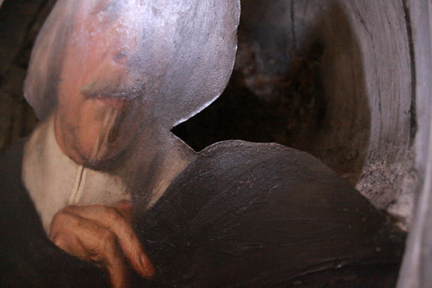In Rome
In the spring of 2013 I conducted exploratory dissertation research in Rome, and in the church of Santa Maria della Pace I came upon the funerary monuments of Gaspare Rivaldi and Ortenzia Mazziotti. Made curious by the appearance of the included portraits, I inquired of the sacristan as to their material. To my surprise, he promptly led me into the chapel, tapped upon Signore Rivaldi’s visage as on the hood of a car, pointed to the over-painted rivets affixing the artwork to its marble frame, and said “aluminum.” Despite the existence in situ of these effigies by Lavinia Fontana since ca. 1611-1614, research in the secondary literature revealed that scholars hadn’t investigated these portraits or any others in Rome. A probable cause may well be the expectation that such paintings had only existed in early modern Wunderkammer collections. The Rivaldi/Mazziotti portraits confound such assumptions by functioning as visual augmentations of the memorializing effect verbalized by the funerary monuments’ epigraphs. Nonetheless, the question remained: Did these artworks represent isolated instances or exemplars of a larger, early-modern phenomenon overlooked by art historians?
In order to answer this question I returned to Rome and between June 14th and July 9th, 2014 I examined the interiors of 137 churches, basilicas, and oratories in all of the city’s neighborhoods (rioni). Within 46 edifices I found 108 funerary monuments that included oil-painted, two-dimensional effigies. Of these, I positively identified 21 on metal, 42 on stone, and documented another 24 in physically-inaccessible positions whose visual characteristics suggest similar supports. Another 26 monuments contain blank, oval spaces where a two-dimensional portrait was, could, or may have been installed. On locating a monument with one of these portraits, I photographed them both and transcribed the accompanying Latin epigraphy. These inscriptions indicate that patrons began installing commemorative paintings into funerary monuments by the 1550s, a practice that became especially popular during the seventeenth century, significantly diminished during the eighteenth century, and then reappeared during the mid-nineteenth century. At this time, Roman patrons returned to commissioning two-dimensional, funerary portraits painted in oils on metal and stone supports, while also ordering many others made with the technique of micro-mosaic. As an odd admixture of both practices, some patrons chose to have artists simulate a micro-mosaic portrait using oil paints on metal supports. All but the Rivaldi/Mazziotti portraits are by as-yet-to-be-identified painters.
Overall, my search established the geographic distribution and chronological frequency of oil-painted funerary portraits in Rome, and that the Rivaldi/Mazziotti effigies epitomize a type of oil painting that remains obscured but not damaged by centuries of grime. Furthermore, the excellent states of preservation exhibited by effigies painted on metal and stone or made as micro-mosaics suggest that patrons chose wisely to memorialize themselves in these materials. Strikingly colorful, physically durable, and reflectively luminescent, funerary effigies painted on stone and metal, and those made in micro-mosaic, succeed in securing the presence of Italian patrons before our eyes.
